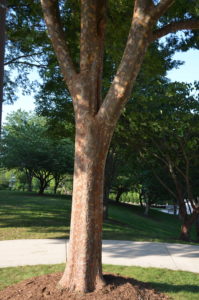Recent storm damage has caused a re-evaluation, whether to continue to plant the cultivar Allee®, also called ‘Emerald Vase’. Urban foresters around the state of Tennessee report that limb breakage and clean up around Allee elms is greater than around other cultivars. Bosque seemed to fare much better.
Lacebark elm (Ulmus parvifolia) is a beautiful medium -sized street and shade tree. Its use in urban street plantings has become popular over the past decade. The three leading cultivars of lacebark elm are Allee®, Athena® and Bosque™.
The tree earns its name from the delightful orange or brown color mosaic or puzzle-like pattern over the main trunk (s) and branches. The autumn leaf color is rarely memorable and the small 1-2 inch leaves fall without much fanfare and leaf litter mess.
Get lacebark elm off to a long and prosperous life by supplying extra water and light fertilize feeding the first two years. In the first two years after planting, a young tree needs deep watering every two weeks in the late spring and summer. An established lacebark elm exhibits exceptional drought tolerance.
If you or your city or town is planting lacebark elm in your housing subdivision, ask a certified arborist in your area which lacebark elm cultivars grow best for your area.


 Posted in
Posted in 
